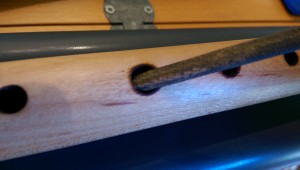11 – Fine Tuning
So – we’ve coarse-tuned – the flute was roughly correct when we left it last night, and it’s now been a good 12-24 hours since we did anything with heat. It is 18°C in our shop, and we’ve cut the block which our flute is going to run the rest of its life with. Play the flute; if it’s easy to “overblow” (it squeaks on some notes, especially low down) then you can GENTLY round off the cliff-edge of the flue, and also the bottom edge of the bird at the flue exit. We’re talking a few light strokes of 600 grit paper at a time and try again, until it blows clear and strong.
Then check the basic pentatonic scale with our tuner and write down the results. We should be getting (we chose a “G” flute, right?) G, Bb, B, C#, Eb, F and G. (Eb is with hole 4 uncovered, holes 3, 5 and 6 covered). Write down how many “cents” low each note is. (If you remember we stopped short each time and therefore no notes will be higher than the needed one).
So – let’s imagine that the bottom G is 20 cents low. What we do next seems a bit crazy; we tune each note to be 20 cents low when blown with the EXACT same strength as our G was. The way I do this is to use a very fine, half-round needle file to “undercut” the north end of the hole. Insert the file into the hole for the note you’re tuning, pointing North, at an angle of about 30°. File a few strokes with medium pressure at the North end, and at the East and West sides of the hole (a few less at the sides). Then change your angle to 15° and do the same again; and then 45° and do th e same again. 5 or 6 strokes is enough. Blow out the sawdust from the hole and firmly from the South end of the bore; then check your note. Observe how much it’s changed… and then repeat until it’s EXACTLY the same amount low as G was. Do this for the entire scale.
e same again. 5 or 6 strokes is enough. Blow out the sawdust from the hole and firmly from the South end of the bore; then check your note. Observe how much it’s changed… and then repeat until it’s EXACTLY the same amount low as G was. Do this for the entire scale.
Now – with all the holes done, using your bandsaw or a hand tool if you prefer, shorten the flute by TINY stages (less than a mm each time) until the bottom “G” is less than 5 cents out. Check the other notes, and using your file in the holes again, bring any in that are still short of the G.
With this done, you can now check the extended fingering (the “missing” notes). Have a look in Bob Grealish’s Flutopedia page for this fingering; each hole on the flute has a “Cross-Fingered” note; you need to use your file on the SOUTH end of the hole to bring the cross-fingered note in. Double check to see if it’s affecting your “main” pentatonic notes… and if it is, you should use one or two strokes of the file at a time on the North edge to bring them in. Use this creepy-creepy, incremental method until all the notes are as close as you can get to perfect.
That’s it; you’re fine tuned. Check again in 24 hours, to make sure that conditions haven’t changed anything; again you need to be doing this at 18°C room temperature OR you need to be compensating for the actual temperature. Bob Grealish’s spreadsheet has temperature compensation built-in; but you need a tuner which has an “A=” setting to drift its tuning out. My tuner goes from 435Hz to 445Hz enabling me to tune in temperatures from 12°C to 25°C (53 to 77°F). Don’t try to guess this; use Bob’s spreadsheet by entering your temperature at the bottom of the “Pentatonic Mode 1/4” sheet and it’ll tell you what to set your tuner to.